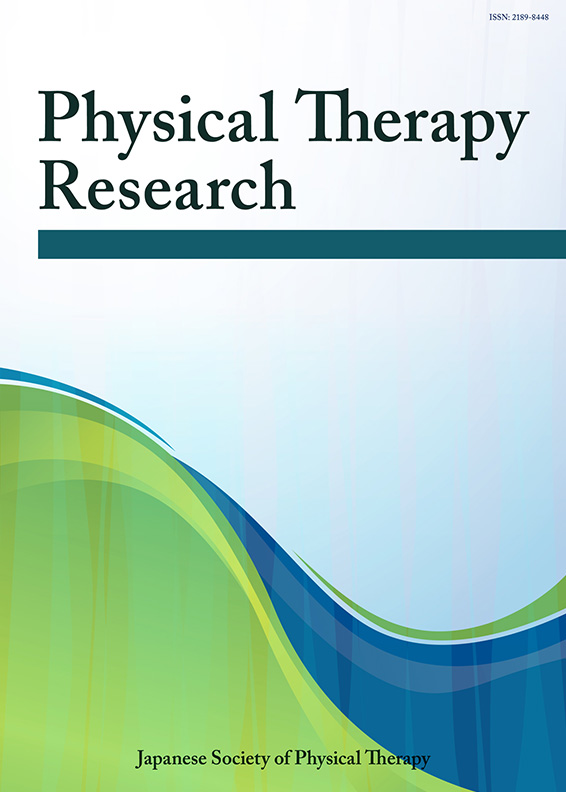Editorial Board
Welcome Message from Editor-in-Chief
Dear authors, reviewers and readers of Physical Therapy Research,
Physical Therapy Research, formerly known as the Journal of the Japanese Physical Therapy Association, was established in 1998. As we celebrate the 24th anniversary of our inaugural issue, Physical Therapy Research continues to provide valuable information to physical therapists and related researchers in Japan and around the world. I am proud to assume the position of Editor-in-Chief of Physical Therapy Research, which has published high quality articles with the support of many editors.
At present, the Editorial Board of Physical Therapy Research consists of the Editor-in-Chief and 32 Editorial Board members who carry out the editorial work. Over the past three years, the acceptance rate of Physical Therapy Research has averaged 39%, with acceptance or rejection being based on rigorous peer review.
In terms of submission numbers, there has been a noticeable upward trend over the past 13 years, particularly since 2017, and a significant increase in 2020. However, the publication ceased to be published in paper form and only was published online since 2017. It is unclear whether this will have any further impact on the recent increase in the number of submissions.
The main challenge is to obtain an impact factor to ensure an ever-increasing quality and quantity of research papers. Capitalizing on the transition to a fully online format, we are actively preparing Physical Therapy Research to evolve into an online journal. Our ultimate goal is to register it with the Emerging Sources Citation Index. This strategic move will enable wider dissemination of valuable research in the field of physical therapy and strengthen the journal's impact in the academic sphere. To achieve this, it is necessary to internationalize the editorial board and we hope that overseas researchers will participate as editorial board members. Additionally, expanding the number of submissions from international contributors presents a significant challenge. To address this, we are working towards the advancement of Physical Therapy Research, with the support of the Japan Science and Technology Agency.
As an editorial policy, I do not propose any radical changes, however it is crucial that Physical Therapy Research continues to evolve and embrace the rapidly changing world of publishing and information dissemination. For original articles, we welcome research that focuses on people with physical therapy needs, rather than research that focuses on healthy adults. The methodological quality of publications has improved dramatically over the last 15 years, influenced by reporting standards guidelines such as CONSORT, STROBE, and PRISMA. We will encourage all authors to work to these standards. For studies that do not involve human subjects, it should be clearly stated how the results of the study could be of benefit to physical therapy. In addition, we welcome submissions of systematic reviews, case reports, practice reports and survey reports that have important implications for the practice of physical therapy.
We look forward to receiving submissions from a wide range of researchers. Let's work together to advance the science of physical therapy.
June 2023
Hiroyuki SHIMADA
Editor-in-Chief
Physical Therapy Research
Editorial Board
Editor-in-Chief
Hiroyuki SHIMADA (National Center for Geriatrics and Gerontology, Aichi, Japan)
Deputy Editors
- Hiroyuki HASHIDATE (Kyorin University, Tokyo, Japan)
- Ryo KOZU (Nagasaki University, Nagasaki, Japan)
- Harutoshi SAKAKIMA (Kagoshima University, Kagoshima, Japan)
- Kenichi SUGAWARA (Kanagawa University of Human Services, Kanagawa, Japan)
- Eiki TSUSHIMA (Hirosaki University, Aomori, Japan)
Editors
- Seongryu BAE (Dong-A University, Korea)
- Munkh-Erdene BAYARTAI (Mongolian National University of Medical Sciences, Mongolia)
- Rumpa BOONSINSUKH (Srinakharinwirot University, Thailand)
- Vinicius CAVALHERI (Curtin University, Australia)
- Takehiko DOI (National Center for Geriatrics and Gerontology, Aichi, Japan)
- Gohei KATO (Tokyo Professional University of Health Sciences, Tokyo, Japan)
- Mushfiquddin KHAN (Medical University of South Carolina, USA)
- Kazuhiro HARADA (Kibi International University, Okayama, Japan)
- Daisuke HIGUCHI (Takasaki University of Health and Welfar, Gunma, Japan)
- Tatsuya HIRASE (Kanagawa University of Human Services, Kanagawa, Japan)
- Tomoya ISHIGAKI (Nagoya Gakuin University, Aichi, Japan)
- Fuminari KANEKO (Tokyo Metropolitan University, Tokyo, Japan)
- Tatsuya KASUYAMA (Health Science University, Yamanashi, Japan)
- Kenichi KONO (International University of Health and Welfare, Chiba, Japan)
- Masafumi KUBOTA (Kanazawa University, Ishikawa, Japan)
- Yasuaki KUSUMOTO (Fukushima Medical University, Fukushima, Japan)
- Noriaki MAEDA (Hiroshima University, Hiroshima, Japan)
- Hyuma MAKIZAKO (Kagoshima University, Kagoshima, Japan)
- Shinichiro MORISHITA (Fukushima Medical University, Fukushima, Japan)
- Ken MURAMATSU (Kyorin University, Tokyo, Japan)
- Koutatsu NAGAI (Hyogo Medical University, Hyogo, Japan)
- Yasuhide NAKAYAMA (The Jikei University School of Medicine, Tokyo, Japan)
- Ippei NOJIMA (Nagoya City University, Aichi, Japan)
- Junya OZAWA (Hiroshima International University, Hiroshima, Japan)
- Makoto TAKAHASHI (Hiroshima University, Hiroshima, Japan)
- Minoru YAMADA (Tsukuba University, Tokyo, Japan)
- Tomofumi YAMAGUCHI (Kyoto University, Kyoto, Japan)

